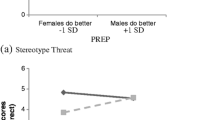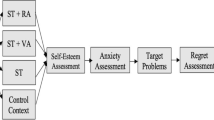Abstract
In the present manuscript we draw on the Multi-Threat Framework to explore gender-related math attitudes and how they put girls and women at risk for stereotype threats. Gunderson et al. (2011) detail how negative stereotypes about women’s math abilities are transmitted to girls by their parents and teachers, shaping girls’ math attitudes and ultimately undermining performance and interest in science, technology, engineering, and math (STEM) fields. The social psychological phenomenon of stereotype threat complements this approach and demonstrates the additional ways in which gender-related math attitudes undermine girls’ and women’s interest and performance in STEM domains. Considering the phenomenon of stereotype threat also identifies how stereotypes and other gender-related math attitudes can undermine women’s and girls’ interest and performance in STEM domains even when women and girls have positive math attitudes.
Similar content being viewed by others
References
Aronson, J., Lustina, M. J., Good, C., Keough, K., Steele, C. M., & Brown, J. (1999). When white men can’t do math: Necessary and sufficient factors in stereotype threat. Journal of Experimental Social Psychology, 35, 29–46. doi:10.1006/jesp.1998.1371.
Beilock, S. L. (2008). Math performance in stressful situations. Current Directions in Psychological Science, 17, 339–343. doi:10.1111/j.1467-8721.2008.00602.x.
Beilock, S. L., Rydell, R. J., & McConnell, A. R. (2007). Stereotype threat and working memory: Mechanisms, alleviation, and spillover. Journal of Experimental Psychology. General, 136, 256–276. doi:10.1037/0096-3445.136.2.256.
Beilock, S. L., Gunderson, E. A., Ramirez, G., & Levine, S. C. (2010). Female teachers’ math anxiety affects girls’ math achievement. Proceedings of the National Academies of Science of the United States of America, 107, 1860–1863. doi:10.1073/pnas.0910967107.
Cadinu, M., Maass, A., Rosabianca, A., & Kiesner, J. (2005). Why do women underperform under stereotype threat? Psychological Science, 16, 572–578. doi:10.1111/j.0956-7976.2005.01577.x.
Cheryan, S., Plaut, V. C., Davies, P. G., & Steele, C. M. (2009). Ambient belonging: How stereotypical cues impact gender participation in computer science. Journal of Personality and Social Psychology, 97, 1045–1060. doi:10.1037/a0016239.
Cheryan, S., Siy, J. O., Vichayapai, M., Drury, B. J., & Kim, S. (2011). Do female and male role models who embody STEM stereotypes hinder women’s anticipated success in STEM? Social Psychological and Personality Science. Advance online publication. doi:10.1177/1948550611405218.
Danaher, K., & Crandall, C. S. (2008). Stereotype threat in applied settings re-examined. Journal of Applied Social Psychology, 38, 1639–1655. doi:10.1111/j.1559-1816.2008.00362.x.
Dasgupta, N., & Asgari, S. (2004). Seeing is believing: Exposure to counterstereotypic women leaders and its effect on the malleability of automatic gender stereotyping. Journal of Experimental Social Psychology, 40, 642–658. doi:10.1016/j.jesp.2004.02.003.
Davies, P. G., Spencer, S. J., Quinn, D. M., & Gerhardstein, R. (2002). Consuming images: How television commercials that elicit stereotype threat can restrain women academically and professionally. Personality and Social Psychology Bulletin, 28, 1615–1628. doi:10.1177/014616702237644.
Davies, P. G., Spencer, S. J., & Steele, C. M. (2005). Clearing the air: Identity safety moderates the effects of stereotype threat on women’s leadership aspirations. Journal of Personality and Social Psychology, 88, 276–287. doi:10.1037/0022-3514.88.2.276.
Frantz, C. M., Cuddy, A. J. C., Burnett, M., Ray, H., & Hart, A. (2004). A threat in the computer: The race implicit association test as a stereotype threat experience. Personality and Social Psychology Bulletin, 30, 1611–1624. doi:10.1177/0146167204266650.
Goff, P. A., Steele, C. M., & Davies, P. G. (2008). The space between us: Stereotype threat and distance in interracial contexts. Journal of Personality and Social Psychology, 94, 91–107. doi:10.1037/0022-3514.94.1.91.
Good, C., & Aronson, J. (1998). Stereotypes in the calculus classroom: Men’s and women’s perceptions of sex-differences. Unpublished data. The University of Texas at Austin.
Good, C., Aronson, J., & Harder, J. A. (2008). Problems in the pipeline: Stereotype threat and women’s achievement in high-level math courses. Journal of Applied Developmental Psychology, 19, 17–28. doi:10.1016/j.appdev.2007.10.004.
Gunderson, E. A., Ramirez, G., Levine, S. C., & Beilock, S. L. (2011). The role of parents and teachers in the development of gender-related math attitudes. Sex Roles, this issue. doi:10.1007/s11199-011-9996-2.
Huguet, P., & Régner, I. (2007). Stereotype threat among school girls in quasi-ordinary classroom circumstances. Journal of Educational Psychology, 99, 545–560. doi:10.1037/0022-0663.99.3.545.
Huguet, P., & Régner, I. (2009). Counter-stereotypic beliefs in math do not protect school girls from stereotype threat. Journal of Experimental Social Psychology, 45, 1024–1027. doi:10.1016/j.jesp.2009.04.029.
Inzlicht, M., & Ben-Zeev, T. (2000). A threatening intellectual environment: Why females are susceptible to experiencing problem-solving deficits in the presence of males. Psychological Science, 11, 365–371. doi:10.1016/j.jesp.2009.04.029.
Jamieson, J. P., & Harkins, S. G. (2007). Mere effort and stereotype threat performance effects. Journal of Personality and Social Psychology, 93, 544–564. doi:10.1037/0022-3514.93.4.544.
Jamieson, J. P., & Harkins, S. G. (2009). The effect of stereotype threat on the solving of quantitative GRE problems: A mere effort interpretation. Personality and Social Psychology Bulletin, 35, 1301–1314. doi:10.1177/0146167209335165.
Johns, M., Schmader, T., & Martens, A. (2005). Knowing is half the battle: Teaching stereotype threat as a means of improving women’s math performance. Psychological Science, 16, 175–179. doi:10.1111/j.0956-7976.2005.00799.x.
Johns, M., Inzlicht, M., & Schmader, T. (2008). Stereotype threat and executive resource depletion: Examining the influence of emotion regulation. Journal of Experimental Psychology. General, 137, 691–705. doi:10.1037/a0013834.
Keller, J., & Dauenheimer, D. (2003). Stereotype threat in the classroom: Dejection mediates the disrupting threat effect on women’s performance. Personality and Social Psychology Bulletin, 29, 371–381. doi:10.1177/0146167202250218.
Kray, L. J., Thompson, L., & Galinsky, A. (2001). Battle of the sexes: Gender stereotype confirmation and reactance in negotiations. Journal of Personality and Social Psychology, 80, 942–958. doi:10.1037/0022-3514.80.6.942.
Levy, B. (1996). Improving memory in old age through implicit self-stereotyping. Journal of Personality and Social Psychology, 71, 1092–1107. doi:10.1037/0022-3514.71.6.1092.
Lippa, R. A., Collaer, M. L., & Peters, M. (2010). Sex differences in mental rotation and line angle judgments are positively associated with gender equality and economic development across 53 nations. Archives of Sexual Behavior, 39, 990–997. doi:10.1007/s10508-008-9460-8.
Logel, C., Walton, G. M., Spencer, S. J., Iserman, E. C., von Hippel, W., & Bell, A. E. (2009). Interacting with sexist men triggers social identity threat among female engineers. Journal of Personality and Social Psychology, 96, 1089–1103. doi:10.1037/a0015703.
Maass, A., D’Ettole, C., & Cadinu, M. (2008). Checkmate? The role of gender stereotypes in the ultimate intellectual sport. European Journal of Social Psychology, 38, 231–245. doi:10.1002/ejsp.440.
Martens, A., Johns, M., Greenberg, J., & Schimel, J. (2006). Combating stereotype threat: The effect of self-affirmation on women’s intellectual performance. Journal of Experimental Social Psychology, 42, 236–243. doi:10.1016/j.jesp.2005.04.010.
Marx, D. M., & Roman, J. S. (2002). Female role models: Protecting women’s math test performance. Personality and Social Psychology Bulletin, 28, 1183–1193. doi:10.1177/01461672022812004.
Marx, D. M., Stapel, D. A., & Muller, D. (2005). We can do it: The interplay of construal orientation and social comparisons under threat. Journal of Personality and Social Psychology, 88, 432–446. doi:10.1037/0022-3514.88.3.432.
McGlone, M. S., & Aronson, J. (2006). Stereotype threat, identity salience, and spatial reasoning. Journal of Applied Developmental Psychology, 27, 486–493. doi:10.1016/j.appdev.2006.06.003.
McGlone, M. S., Aronson, J., & Kobrynowicz, D. (2006). Stereotype threat and the gender gap in political knowledge. Psychology of Women Quarterly, 30, 392–398. doi:10.1111/j.1471-6402.2006.00314.x.
McIntyre, R. B., Paulson, R. N., & Lord, C. G. (2003). Alleviating women’s mathematics stereotype threat through salience of group achievements. Journal of Experimental Social Psychology, 39, 83–90. doi:10.1016/S0022-1031(02)00513-9.
Miyake, A., Kost-Smith, L. E., Finkelstein, N. D., Pollock, S. J., Cohen, G. L., & Ito, T. A. (2010). Reducing the gender achievement gap in college science: A classroom study of values affirmation. Science, 330, 1234–1237. doi:10.1126/science.1195996.
Muzzatti, B., & Agnoli, F. (2007). Gender and mathematics: Attitudes and stereotype threat susceptibility in Italian children. Developmental Psychology, 43, 747–759. doi:10.1037/0012-1649.43.3.747.
Neuville, E., & Croizet, J.-C. (2007). Can salience of gender identity impair math performance among 7–8 years old girls? The moderating role of task difficulty. European Journal of Psychology of Education, 22, 307–316. doi:10.1007/BF03173428.
Quinn, D. M., Kahng, S. K., & Crocker, J. (2004). Discreditable: Stigma effects of revealing a mental illness history on test performance. Personality and Social Psychology Bulletin, 30, 803–815. doi:10.1177/0146167204264088.
Rosenthal, H. E. S., & Crisp, R. J. (2006). Reducing stereotype threat by blurring intergroup boundaries. Personality and Social Psychology Bulletin, 32, 501–511. doi:10.1177/0146167205281009.
Rydell, R. J., McConnell, A. R., & Beilock, S. L. (2009). Multiple social identities and stereotype threat: Imbalance, accessibility, and working memory. Journal of Personality and Social Psychology, 96, 949–966. doi:10.1037/a0014846.
Schmader, T. (2002). Gender identification moderates stereotype threat effects on women’s math performance. Journal of Experimental Social Psychology, 38, 194–201. doi:10.1006/jesp.2001.1500.
Schmader, T., & Johns, M. (2003). Converging evidence that stereotype threat reduces working memory capacity. Journal of Personality and Social Psychology, 85, 440–452. doi:10.1037/0022-3514.85.3.440.
Schmader, T., Johns, M., & Barquissau, M. (2004). The costs of accepting gender differences: The role of stereotype endorsement in women’s experience in the math domain. Sex Roles, 50, 835–850. doi:10.1023/B:SERS.0000029101.74557.a0.
Schmader, T., Johns, M., & Forbes, C. (2008). An integrated process model of stereotype threat effects on performance. Psychological Review, 115, 336–356. doi:10.1037/0033-295X.115.2.336.
Sekaquaptewa, D., & Thompson, M. (2003). Solo status, stereotype threat, and performance expectancies: Their effects on women’s performance. Journal of Experimental Social Psychology, 39, 68–74. doi:10.1016/S0022-1031(02)00508-5.
Shapiro, J. R. (2011). Different groups, different threats: A multi-threat approach to the experience of stereotype threats. Personality and Social Psychology Bulletin, 37, 464–480. doi:10.1177/0146167211398140.
Shapiro, J. R., & Neuberg, S. L. (2007). From stereotype threat to stereotype threats: Implications of a Multi-Threat Framework for causes, moderators, mediators, consequences, and interventions. Personality and Social Psychology Review, 11, 107–130. doi:10.1177/1088868306294790.
Shih, M., Pittinsky, T. L., & Ambady, N. (1999). Stereotype susceptibility: Identity salience and shifts in quantitative performance. Psychological Science, 10, 80–83. doi:10.1111/1467-9280.00111.
Spencer, S. J., Steele, C. M., & Quinn, D. M. (1999). Stereotype threat and women’s math performance. Journal of Experimental Social Psychology, 35, 4–28. doi:10.1006/jesp.1998.1373.
Stangor, C., Carr, C., & Kiang, L. (1998). Activating stereotypes undermines task performance expectations. Journal of Personality and Social Psychology, 75, 1191–1197. doi:10.1037/0022-3514.75.5.1191.
Steele, C. M. (1988). The psychology of self-affirmation: Sustaining the integrity of the self. In L. Berkowitz (Ed.), Advances in experimental social psychology, vol. 21 (Vol. 21, pp. 261–302). New York: Academic.
Steele, C. M. (1997). A threat in the air: How stereotypes shape intellectual identity and performance. American Psychologist, 52, 613–629. doi:10.1037/0003-066X.52.6.613.
Steele, J. R., & Ambady, N. (2006). “Math is hard!” The effect of gender priming on women’s attitudes. Journal of Experimental Social Psychology, 42, 428–436. doi:10.1016/j.jesp.2005.06.003.
Steele, C. M., & Aronson, J. (1995). Stereotype threat and the intellectual test performance of African Americans. Journal of Personality and Social Psychology, 69, 697–711. doi:10.1037/0022-3514.69.5.797.
Steele, C. M., Spencer, S. J., & Aronson, J. (2002). Contending with group image: The psychology of stereotype and social identity threat. Advances in Experimental Social Psychology, 34, 379–440.
Stout, J. G., Dasgupta, N., Hunsinger, M., & McManus, M. A. (2011). STEMing the tide: Using ingroup experts to inoculate women’s self-concept in science, technology, engineering, and mathematics (STEM). Journal of Personality and Social Psychology, 100, 255–270. doi:10.1037/a0021385.
Walton, G. M., & Cohen, G. L. (2003). Stereotype lift. Journal of Experimental Social Psychology, 39, 456–467. doi:10.1016/S0022-1031(03)00019-2.
Walton, G. M., & Cohen, G. L. (2007). A question of belonging: Race, social fit, and achievement. Journal of Personality and Social Psychology, 92, 82–96. doi:10.1037/0022-3514.92.1.82.
Walton, G. M., & Spencer, S. J. (2009). Latent ability: Grades and test scores systematically underestimate the intellectual ability of negatively stereotyped students. Psychological Science, 20, 1132–1139. doi:10.1111/j.1467-9280.2009.02417.x.
Wout, D. A., Shih, M. J., Jackson, J. S., & Sellers, R. M. (2009). Targets as perceivers: How people determine when they will be negatively stereotyped. Journal of Personality and Social Psychology, 96, 349–362. doi:10.1037/a0012880.
Acknowledgement
This research was supported by a National Institutes of Health/National Institute of General Medical Sciences grant (grant number: RC1GM09071) and a National Science Foundation grant (grant number: BCS0956321) awarded to Jenessa R. Shapiro. The authors would like to thank Sapna Cheryan for her comments on an earlier version of this manuscript.
Author information
Authors and Affiliations
Corresponding author
Rights and permissions
About this article
Cite this article
Shapiro, J.R., Williams, A.M. The Role of Stereotype Threats in Undermining Girls’ and Women’s Performance and Interest in STEM Fields. Sex Roles 66, 175–183 (2012). https://doi.org/10.1007/s11199-011-0051-0
Published:
Issue Date:
DOI: https://doi.org/10.1007/s11199-011-0051-0




